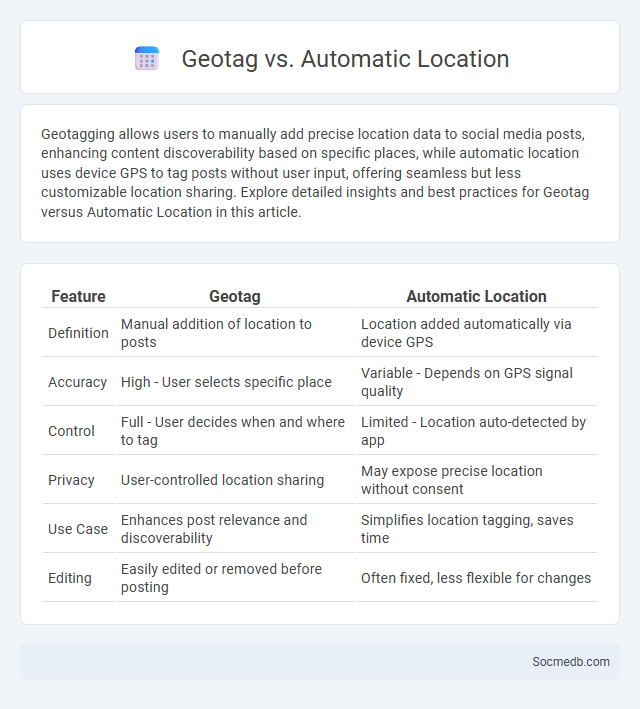
Photo illustration: Geotag vs Automatic Location
Geotagging allows users to manually add precise location data to social media posts, enhancing content discoverability based on specific places, while automatic location uses device GPS to tag posts without user input, offering seamless but less customizable location sharing. Explore detailed insights and best practices for Geotag versus Automatic Location in this article.
Table of Comparison
| Feature | Geotag | Automatic Location |
|---|---|---|
| Definition | Manual addition of location to posts | Location added automatically via device GPS |
| Accuracy | High - User selects specific place | Variable - Depends on GPS signal quality |
| Control | Full - User decides when and where to tag | Limited - Location auto-detected by app |
| Privacy | User-controlled location sharing | May expose precise location without consent |
| Use Case | Enhances post relevance and discoverability | Simplifies location tagging, saves time |
| Editing | Easily edited or removed before posting | Often fixed, less flexible for changes |
Introduction to Location Data in Digital Media
Location data in digital media enhances the relevance and personalization of content by leveraging GPS coordinates, IP addresses, and geotags. Social media platforms use this data to target ads, recommend nearby events, and improve user engagement by tailoring experiences to your geographic context. Understanding how location data influences digital interactions helps you optimize content delivery and marketing strategies effectively.
Understanding Geotag: Definition and Usage
Geotag refers to the process of adding geographical identification metadata to various media such as photos, videos, or social media posts, highlighting the exact location where the content was created or shared. Platforms like Instagram, Twitter, and Facebook utilize geotagging to enhance user engagement by enabling location-based searches, targeted advertising, and personalized content. Understanding geotag usage helps businesses optimize local marketing strategies, improve customer interaction, and track location-specific trends effectively.
What is Automatic Location Tracking?
Automatic location tracking is a technology used by social media platforms to continuously determine a user's geographic position through GPS, Wi-Fi, or mobile network data. This feature enables real-time sharing of locations, targeted advertising, and personalized content by analyzing user movements and check-ins. Privacy concerns arise as users may unintentionally disclose sensitive location information to third parties or unwanted audiences.
Key Differences Between Geotag and Automatic Location
Geotags are user-selected labels that add precise geographical coordinates or place names to social media posts, enhancing location context and searchability. Automatic location, by contrast, is determined using device GPS or network data without manual input, often providing real-time positioning but sometimes less accuracy or control. Understanding these distinctions impacts privacy management, user engagement, and content relevance in platforms like Instagram, Facebook, and Twitter.
Advantages of Using Geotag
Geotags enhance your social media posts by increasing visibility, making content discoverable to users searching specific locations. They enable better engagement by connecting your content with local communities and relevant audiences. Utilizing geotags also improves analytics accuracy, helping you tailor your marketing strategy based on geographic insights.
Benefits of Automatic Location Detection
Automatic location detection on social media enhances user experience by enabling personalized content delivery and targeted advertisements based on precise geographic data. It facilitates real-time check-ins, location-based recommendations, and improved connectivity among users in the same area. Businesses leverage this technology to analyze customer behavior patterns, optimize marketing strategies, and increase local engagement effectively.
Privacy Concerns: Geotag vs Automatic Location
Social media platforms often use geotagging to share a user's precise location, raising significant privacy concerns due to the potential for unauthorized location tracking. Automatic location services continuously collect location data without explicit user input, increasing risks of data breaches and unwanted surveillance. Users must carefully manage location settings to protect personal privacy and control the visibility of their whereabouts on social media networks.
Use Cases: When to Choose Geotag or Automatic Location
Geotagging on social media is ideal for businesses aiming to boost local visibility by tagging exact physical locations, helping users discover nearby services and events. Automatic location features work best for personal posts or real-time updates, providing contextual relevance without manual input. Choosing between geotag and automatic location depends on whether precision and targeted audience engagement or ease of use and spontaneous sharing are a priority.
Best Practices for Leveraging Location Data
Incorporating location data in social media strategies enhances targeting precision and engagement by delivering contextually relevant content to users based on their geographic position. Employing geotagging and location-based analytics enables marketers to track local trends, optimize ad placements, and tailor promotions to specific communities. Protecting user privacy while utilizing location data remains paramount, ensuring compliance with regulations such as GDPR and CCPA to build trust and maintain platform integrity.
Conclusion: Selecting the Right Location Method
Choosing the right location method for social media campaigns enhances targeting precision, increases user engagement, and maximizes return on investment. Understanding your audience's geographic behavior allows you to tailor content that resonates on a local level while maintaining broad reach when necessary. Your strategic decision in location targeting directly impacts the effectiveness and success of your social media marketing efforts.
 socmedb.com
socmedb.com